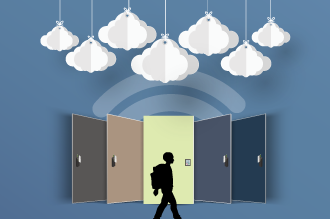Moving to Mesh: Retrofitting a Scattered Campus with Cloud Capabilities

At 8 p.m. on a Thursday night, the principal of a Blytheville high school gets a call from the basketball coach. A group from the team has decided to have a spur of the moment practice session before an upcoming tournament and wants to use the gymnasium.
While sitting on his couch, the principal unlocks the gym for the next hour and sets it to lock back after the team is done.
This is a major improvement over the previous system, which would have required the principal to drive across town, remembering to grab his credentials before leaving so he could unlock the gymnasium.
Now, thanks to Arkansas-based ESA member company Blue Sky Technologies, his job has gotten much easier.
The security integrators at Blue Sky recently retrofitted a wireless access control system for two schools in the Blytheville Public School District.
They replaced the outdated access control system at the district’s high school and junior high school campuses with something that could address a major inefficiency in the school’s existing system, which proved difficult when entering lockdown in the event of an emergency due to the unusually high number of external doors in its floorplan.
SECURING A SCATTERED CAMPUS
Previously, staff had to be assigned to 13 doors spread across the campus in the event of a lockdown.
“The ability to manage an entire system remotely from anywhere became very attractive to them. Because of the layout of the campus and the way it had been added to over the course of 50 years, they had a lot of independent buildings with their own entrances and exits which needed to be secured,” says Brian Duckworth, sales consultant at Blue Sky Technologies.
Blue Sky retrofitted the campus with a system from ProdataKey (PDK) that uses wireless mesh technology to connect access points.
The team used the mesh network to connect 12 of the school’s doors, due to their placement in remote buildings that did not have extra copper or fiber capacity. According to Duckworth, the wireless solution had worked flawlessly on multiple projects, regardless of the age of the buildings or the density of their layout.
“The remote buildings that would have typically required us to use existing fiber and/or run fiber to the buildings; all that cost was negated by the ability to use the wireless mesh architecture built into the PDK solution,” says Duckworth.
In addition to being more cost-effective than a wire-based replacement, the new solution provided the ability for quicker responses to emergencies, as well as more convenient implementation of daily security measures.
Because the system can be controlled with a smartphone app, the various entrance points and exits scattered across the campus could swap states instantly with the push of a button.
Blue Sky also worked with administrators to set up an automatic locking and unlocking routine for the doors based on the school’s bell schedule. This would allow students to move between buildings when swapping classes, but the doors would lock within a couple minutes of the tardy bell ringing.
Installing this system was not without its challenges; because of the substantial updates, the doors had to be replaced to implement the new system. There were also challenges due to the construction of the buildings, which were made with hard deck ceilings and cinder block walls, providing little to no access in many places.
“This was all done over the course of a winter break, so they had the door installation company come in and replace the doors so [the system] would fit properly. We replaced all the hardware, and because they had existing access control, we had to replicate existing cards and credentials across both systems so the cards would work on both,” says Duckworth.
The installation was only the beginning – the Blue Sky team also conducted training for everyone who would be using the system on a regular basis. This was an important touchpoint, according to Duckworth.
“After the initial install, all the information gathering and programming of the system, all the users were trained pretty much top-to-bottom,” says Duckworth. “We trained them on adding and deleting users, modifying users, changing their roles and credentials and operating the system itself. We showed all the administrators how to invoke a lockdown if there were any type of active shooter scenario on campus that required that.”
Duckworth says the crew also explained to the staff how the hierarchy of credentials would work. They worked with the technical staff, school resource officer and school administrators to determine who should have what level of control and then trained everyone accordingly.
DISCOVERING THE NEED
To provide this system, Blue Sky had to work with the district to discover what their needs were. The company had an existing relationship with the school district, which they were very careful to maintain by providing continual service that exceeded expectations.
Duckworth emphasized that a successful integration for an access control project at a school, or any facility for that matter, depends on an understanding of the client’s situation.
“It all starts with the engagement to understand their specific needs. At the end of the day, their security objectives have driven a lot of what was focused on. We want to ensure that these campuses are as safe as possible for our students, the faculty and administrators. Normally, when we have that focus in mind, everything else comes into place,” says Duckworth. “For us, we’re lucky that their needs paired up with our capabilities and we had great product that would address that more competitively than anybody else at the table.”
For schools specifically, Duckworth says that every situation is different. Sometimes he has had more success reaching out to technical employees of the district first, and other times it was better to contact administrative staff. For this project, once the company had established rapport and secured the assignment, the process of uncovering the best solution began.
“Typically for these engagements we start with the technical coordinator, who lays out the technical requirements. At that point, we bring in the security resource officer who has a separate set of objectives. They’re from a law enforcement background, so they’re looking at things from a strategic perspective as opposed to technological. So we got their input as well as input from all the administrators and superintendents at the local school level to understand what their needs were.”
After acquiring this deeper understanding, the Blue Sky team was prepared to provide a stellar solution for the school district. Seeing the benefits of the system installed by Blue Sky, the school district already has begun scaling the access control upgrade to other sites as their budget allows.
Duckworth says the schools with the updated systems in place might soon add more services, such as time and attendance tracking and visitor management, layered on top of the infrastructure his team has provided.
This extra opportunity for revenue likely would come because of how Blue Sky presented the system to the school district, according to Duckworth.
“In those areas where we can improve operational efficiencies, really drive productivity and impact the return on investment – that’s really what it’s about. We’ve tried moving from a technological discussion to a financial discussion, and that’s all driven by the total cost of ownership and ultimately cost for them to own the solution throughout its life cycle,” says Duckworth. “That’s been the approach – to dig into what the current costs are and determine how we can leverage the new technology and the benefits it brings with it.”
For those interested in providing access control or security solutions to school districts, Duckworth recommended building relationships with school administrators at the local level to better understand what their current systems are like and what their needs are.
“At the end of the day, a box is a box is a box,” says Duckworth. “Anybody can sell a box; selling a system isn’t the hard part, keeping a customer – that’s difficult. And that all comes down to a relationship.”




